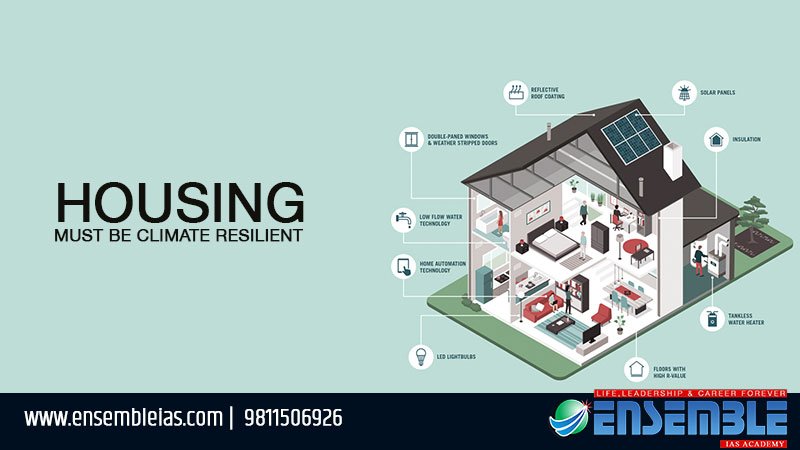Housing : Whatever happens in our nature is not always in the control of human being. In many instances we do see the global warming taking place not only in India but throughout the world. For example – Delhi recorded its second warmest February since 1901, (with a mean maximum temperature (MMT) of 27.9 degrees Celsius, eclipsed only by 2006 when MMT was 29.7 degrees, as announced by the India Meteorological Department).
Thus to adapt to a warming world, India needs to construct buildings that are
- Thermally comfortable
- Buildings having natural daylight; and
- Proper ventilation is a must.
Fewer Western Disturbances causing higher Temperature
This happened because of clear skies, caused by fewer western disturbances. The higher temperature causes many peripheral areas putting chain effects such as:
- The high temperature also led to a slight spike in the power demand.
- Even though it is an isolated weather phenomenon it led to the rise in February temperatures.
- The climate crisis is leading to a warmer world.
- This is leading to an increase in the demand for cooling, pushing up consumption from coal-fired electricity plants.
- Air-conditioners (ACs), which use high global warming-potential refrigerants, are also turning cities into heat islands. (An urban heat island (UHI) refers to a phenomena, particularly in urban areas which are significantly warmer than its surroundings. This temperature difference usually is larger at night than during the day and larger in winter than in summer, and is most apparent when winds are weak. Urban heat island effect are changes in the land surface by urban development along with waste heat generated by energy use. With rapid population increase, urban centres grow, they tend to change greater areas of land which then undergo a corresponding increase in average temperature).
To buy our online courses Click Here
To mitigate this problem, the principles that must be followed —
- View infrastructure systemically. Looking at infrastructure as part of a system provides the broadest, least expensive, and most effective opportunities to achieve resilience.
- Take an iterative, multi-hazard approach. Infrastructure often fails as a result of a combination of natural events and breakdowns in social, technological, or institutional systems. However, conventional risk-management approaches typically consider only one stressor or risk at a time.
- Improve and inform cost-benefit analysis (CBA). CBA plays an important role in shaping infrastructure choices. Yet as it is traditionally practiced, CBA can lead to less-resilient choices.
- Mainstream nature-based infrastructure. The use of nature-based, or green, solutions as either alternatives or complements to conventional (gray) infrastructure can help reduce risks, enhance resilience, and support other objectives (such as the creation of green space and recreation areas). A combination of nature-based and conventional infrastructure may increase overall resilience.
- Jump-start resilience with immediate actions.Some measures have low or no incremental cost and little potential for later regret. While these rapidly deployable measures are not a substitute for longer-term solutions, they can be useful starting points to reduce risk, demonstrate results, and build support for larger measures.
- Plan now to build back better.Building back better can save money, and post-disaster periods can provide unique windows of opportunity to promote resilience. While making the building the ideas must be focused towards-
- Ensuring window shading and ventilation,
- Insulating walls and roofs, and
- Sharing of walls between two buildings.
- This focus on natural thermal comfort will minimise the use of ACs, and using less/reusing building material will mean less use of natural resources.
- To take advantage of this opportunity, planning should therefore occur well in advance of disasters so that strategies have are followed by every stakeholders and the management as well as conservation are a part of the core planning.
Read Also: SATSFY THE HIDDEN HUNGER FOR FOOD SECURITY
To kickstart this green housing revolution, states must adopt the Eco-Niwas Samhita Part I, an energy conservation building code for residential buildings, which was launched by the Bureau of Energy Efficiency in 2018. This sets standards to
- Limit heat gains (for cooling-dominated climates such as Temperate Climate),
- Limit heat loss (for heating-dominated climates in Tropical countries), and
- Ensure natural ventilation and daylight potential.
Unfortunately, the codes are voluntary, and many states have not dovetailed them into their by-laws.
2nd March 2021 | UPSC GS Paper-3 | Editorial | Housing |This article is based on “Housing must be climate-resilient”,
published in Hindustan Times on 02/03/2021. In this article the importance of climate and many of its factors that affect our buildings has been explained.




